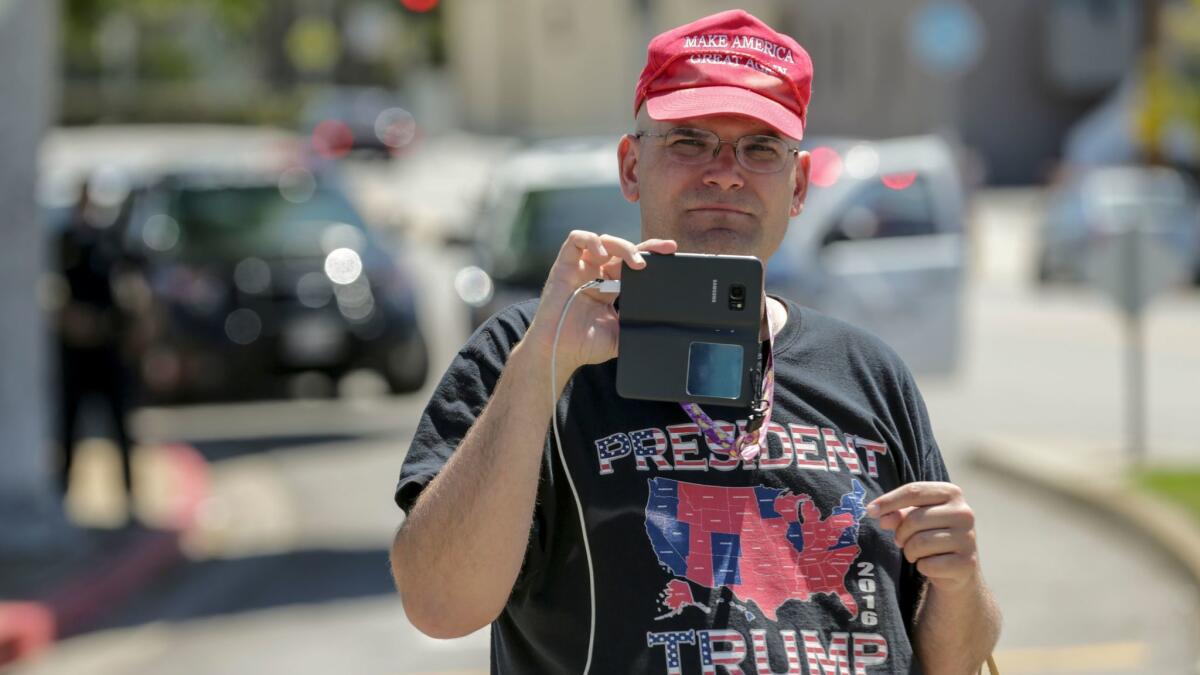Newsletter: Essential California: In blue California, the resistance to the âresistanceâ trolls on

Good morning, and welcome to the Essential California newsletter. It is Saturday, June 3. Hereâs what you donât want to miss this weekend:
TOP STORIES
The resistance to the resistance: The best way to describe Arthur Christopher Schaper is that he represents the resistance to the resistance, a Californian who delights in upending city council meetings in so-called sanctuary cities and shouting down Democratic politicians. The unemployed 36-year-old from Torrance can be easily spotted. Heâs the loud guy in the sweat-stained Make America Great Again hat. Los Angeles Times
The alliance fights back: An alliance of states and cities led by California Gov. Jerry Brown and former New York City Mayor Michael Bloomberg is moving aggressively to do what President Trump wonât: Carry the U.S. to meeting its Paris accord commitments. But the question is whether they can succeed. Los Angeles Times
Major court case: For the first time in 16 years, the California Supreme Court has found that racial bias improperly tainted a jury selection, prompting the court to overturn three convictions â two for attempted murder. Los Angeles Times
This is just a test: The West Coastâs sprawling earthquake early warning system is being tested and is actually working even as President Trump threatens to gut its funding. Los Angeles Times
Gun bust: âA Pasadena police lieutenant, whose Sierra Madre home was raided by federal authorities in February, may have sold dozens of guns online in the last four years, potentially violating state and federal laws barring officers from making a profit from certain firearm sales.â Los Angeles Daily News
THE STORY BEHIND THE STORY
Frank Shyongâs Twitter bio says it all. Heâs an â@latimes writer covering China in Los Angeles.â His beat, which includes covering other Asian American communities, has taken him many places and his latest story is a stunner. It involves a terminally ill mother who decides to kill her son. He explains:
EC: How did you first hear about this story?
FS: I saw the headlines about the shooting in 2015 and planned to look into it later. The initial reports about the shooting lacked some key points â the son Georgeâs schizophrenia, the mother Laiâs illness and her fears that he would become a mass shooter â and I eventually moved on. But at the urging of my editor Bob Sipchen, I began reporting on it in earnest in January of this year.
EC: Aside from it being such a crazy yarn, why did you think it was important to tell?
FS: Iâve been looking for a story that could draw attention to the specific challenges Asian immigrants face when confronting mental illness. And aside from that, Hangâs story demanded context. Laiâs childhood friend Ping said it best in the story: âPeople will only remember her as the mother who shot her son. But she was more.â
EC: What were the high and low points of your reporting?
FS: The low point came in January. I had been chasing a court file that seemed to bouncing between courthouses in downtown and El Monte, and when I finally located the correct documents, they told me that Lai Hang died a few weeks earlier. I grieved for the way she had died alone, and was saddened that I would never get to hear her side of things. The high point was meeting Ping and being able to provide her with some concrete answers. She didnât know George had schizophrenia, and she had spent the last two years struggling with how to remember her best friend.
EC: What was the hardest part of reporting this piece?
FS: The biggest challenge was finding someone who might have known what was going on. Patient confidentiality laws mean that no one involved in Georgeâs care could speak to the issue. I found out that Ping was Hangâs friend from court records, and through public records searches, learned that she worked at a ginseng store in the San Gabriel Valley. Over the course of a month, Iâd call and leave messages at the store, stop by the store on the way to other appointments to see if she was there and leave notes for the other employees to give to her. If she was unwilling to speak I would have understood and moved on. But I needed to ask her face to face and explain what I wanted to do with the story first. Finally, another employee set up a meeting between us, and she agreed to speak.
EC: In the course of reporting, did you come across anything that surprised you?
FS: I knew that cultural stigmas affect the way Asian Americans deal with mental illness. But I was surprised to learn that Lai was not an especially superstitious person. Her silence had more to do with how Asian families deal with hardship â how grief makes people quiet, and how suffering and pain are never discussed in public. Itâs a silence that I think anyone growing up in an Asian American family would recognize. The story shows how this silence can be damaging.
EC: Is there anything that didnât make it into the story, that youâd like readers to know?
FS: Ping decided she would speak with me the day after Lai was buried. She told me that she wanted families like hers and Laiâs to know that there was a different road to walk, and that she wanted to prevent other people from making the same mistakes she and Lai did, that people should talk about this issue. She was very brave to break that silence, and Iâm grateful to her.
Also, after the story ran, some people caring for mentally ill children wrote to me because they felt that my portrayal of the options available to them and Lai was too rosy. They wanted to tell me that even if you do everything correctly, people can fall through the cracks, that mental institutions are expensive, and things can easily go wrong when the police get involved. And even if everything goes correctly, there is still a lifetime of hardship and isolation to live. Thatâs a fair criticism, and itâs a reminder that there is a lot of work left to do.
This weekâs most popular stories in Essential California:
1. Celebrity developer pleads no contest to Bel-Air mega-mansion charges. But what happens to the 30,000-square-foot estate? Los Angeles Times
2. Loma Linda residents live a really, really long time. Itâs not because of their health insurance. Los Angeles Times
3. Rep. Adam Schiff went to the Trump White House. It got weird. Los Angeles Times
4. Whatâs behind the dramatic rise in L.A. Countyâs homeless population. Los Angeles Times
5. Video shows great white shark attacking kayaker in Monterey Bay. San Francisco Chronicle
ICYMI, here are this weekâs Great Reads
The changing theater: As the act of watching a movie is transformed, Times critic Christopher Hawthorne wonders whether the multiplex can stay in the picture. Los Angeles Times
A toast to a sushi joint: The Sushi temple known as Nobu is celebrating its 30th anniversary. Over the decades the Hollywood haunt has turned into a global empire. Hereâs an oral history of how the restaurant came to be a haven for celebrities and moguls alike. The Hollywood Reporter
The nut thieves: âIn California, millions of dollarsâ worth of almonds, walnuts, and pistachios are disappearing. Farmers are perplexed, the cops are confused, and the crooks are getting richer.â Outside
All alone: Big Sur is lonelier and more isolated than ever. Read here about how two friends made the arduous trek into this newly cut-off slice of California. KQED
A long road back: A mother who was paralyzed by a falling tree branch in San Francisco continues to struggle after her accident. San Francisco Chronicle
Looking ahead
Sunday: Crossroads of the West Gun Show at Orange County fairgrounds.
Monday: Groundbreaking for new residential construction at Jordan Downs in South L.A.
Friday: LGBT Night at Dodger Stadium.
Please let us know what we can do to make this newsletter more useful to you. Send comments, complaints and ideas to Benjamin Oreskes and Shelby Grad. Also follow them on Twitter @boreskes and @shelbygrad.
More to Read
Sign up for Essential California
The most important California stories and recommendations in your inbox every morning.
You may occasionally receive promotional content from the Los Angeles Times.











